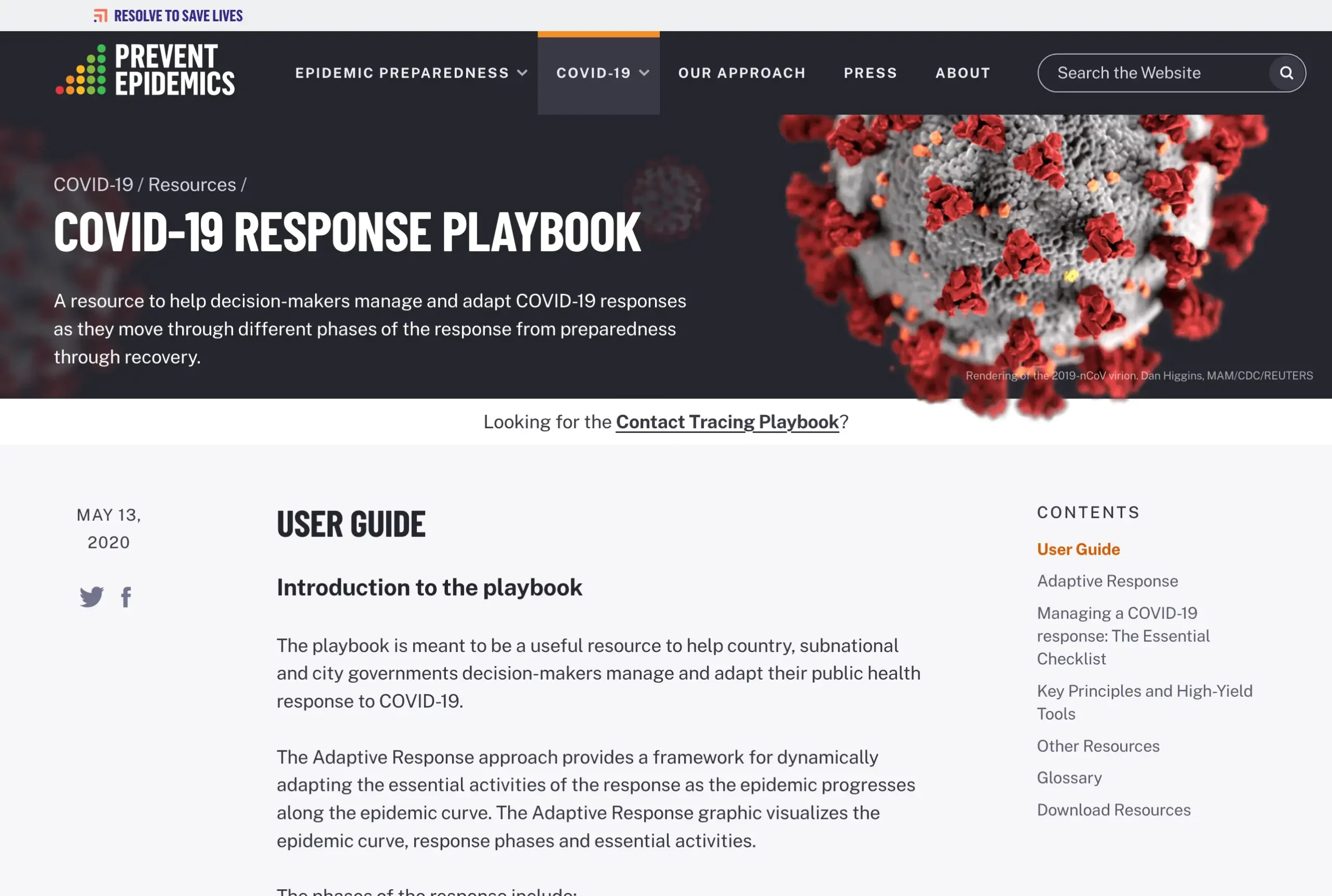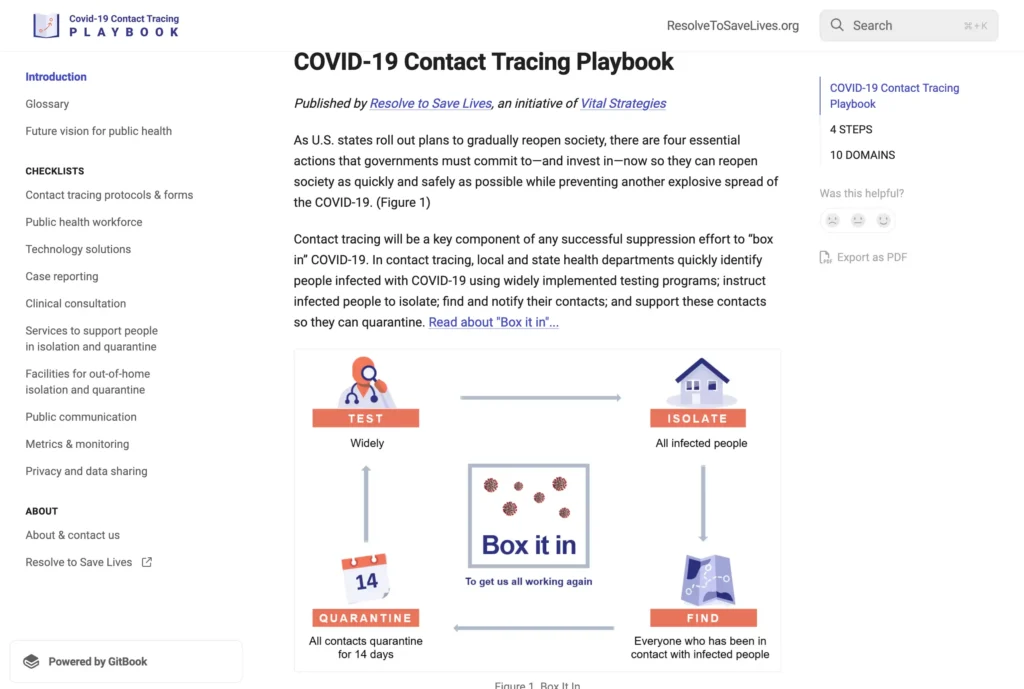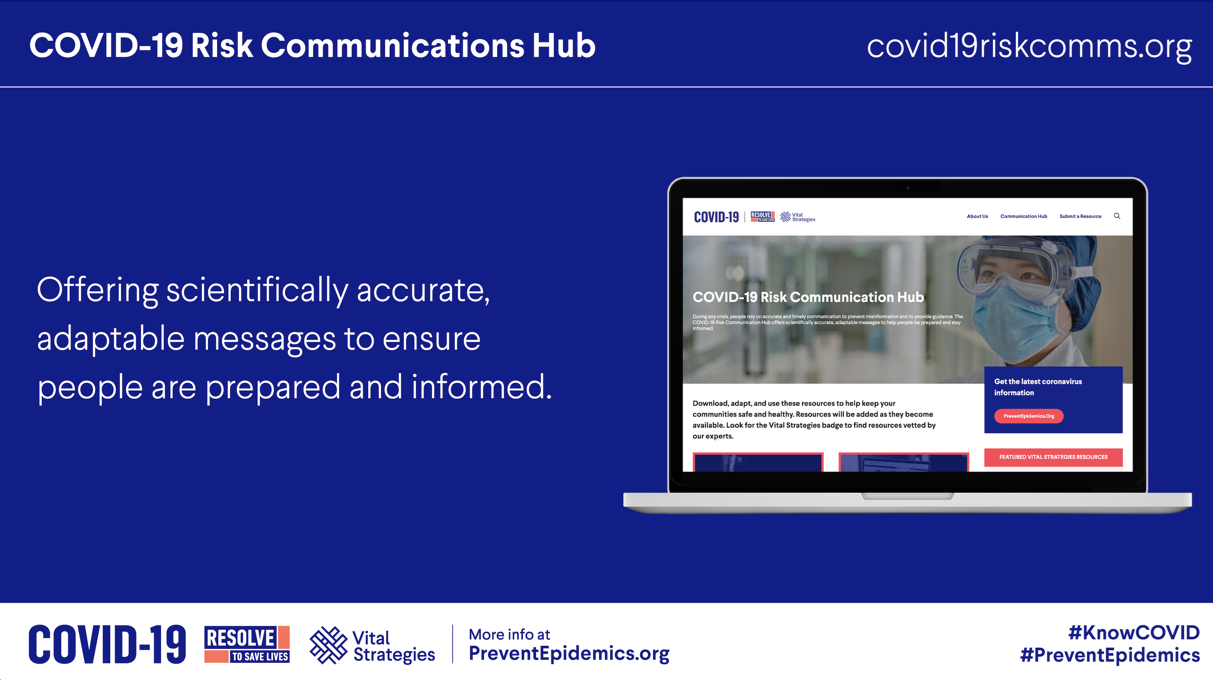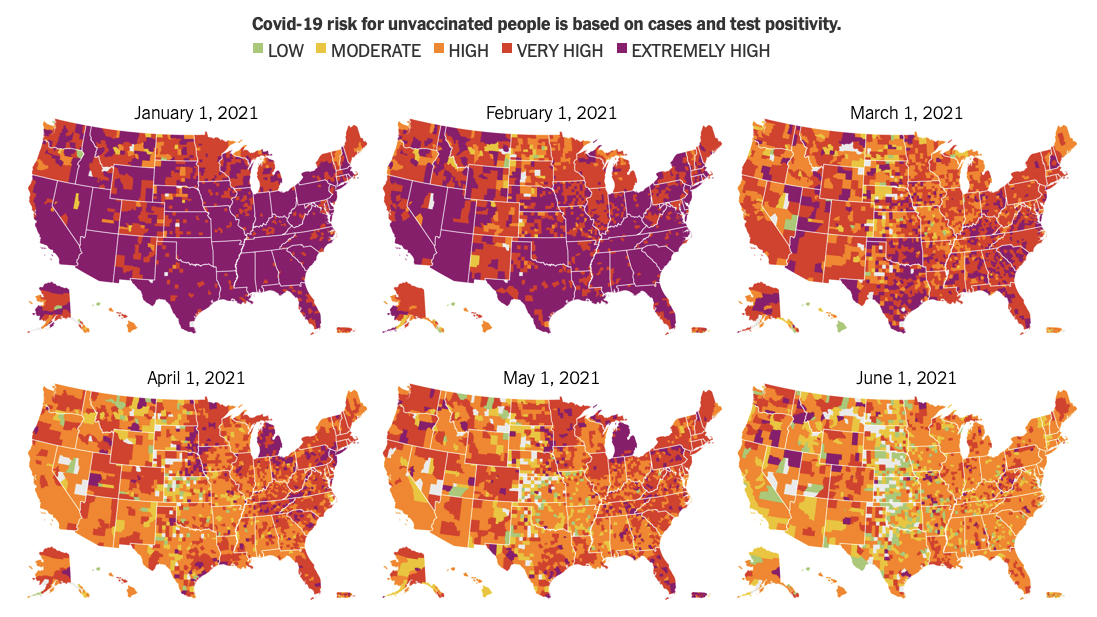You’ve been redirected from preventepidemics.org.
Prevent Epidemics is part of resolvetosavelives.org.
How we save lives / Epidemic prevention / COVID-19
COVID-19
Epidemic prevention is part of our DNA

Resolve to Save Lives was founded in 2017 with a mission to make the world safer from epidemics, with a particular focus on lower-income countries where strategic partnerships and targeted interventions can make tremendous impact.

Motivated by those efforts—quick case detection, immediate notification to public health authorities and swift, appropriate response actions—our team took an innovative approach to a common assessment of general epidemic readiness across several countries to create awareness of gaps in the world’s preparedness for the next epidemic. Building on WHO’s Joint External Evaluation (JEE), we developed a “Ready Score” to give each country a single number to quantify just how prepared they were to deal with the next epidemic. Those results showed countries had substantial work to do to become even moderately prepared, and so we began working with them to bridge those critical gaps in preparedness and response.
No one was prepared for the largest pandemic in more than a century. COVID-19 was a wake-up call for the worldBy the time SARS-CoV-2 began spreading in late 2019, many countries with whom we partnered were gaining substantial improvements in their Ready Scores, but no one was prepared for the largest pandemic in more than a century. COVID-19 was a wake-up call for the world, and a turning point in assessing our collective ability to prevent, detect and respond to outbreaks. Building on our learnings from the Ebola outbreak, and years of experience working with high-risk countries across the globe, our team launched several initiatives as our contribution to responding to this unprecedented public health crisis.
No one was prepared for the largest pandemic in more than a century. COVID-19 was a wake-up call for the world
Our response to the largest pandemic in more than a century

COVID-19 Response Playbook
By May 2020, our team developed a comprehensive COVID-19 Response Playbook as a resource to help local, regional and national government decision-makers manage and adapt their public health response to the pandemic. Our playbook incorporated WHO guidance and expert advice to provide practical frameworks for rapidly focusing on essential activities and provided an adaptive response framework to switch activities as the epidemic unfolded from disease emergence to widespread transmission to suppression and control.
We organized essential activities into four categories:
- Coordinated response
- Disease control
- Case management
- Physical distancing

To support countries in delivering an adaptive response, we developed several supplementary strategic and technical documents, including decision tools on how and when to stop contact tracing using timeliness and an assessment of lab turn-around timeliness. To support decision making in a transparent and accountable way, we also developed indicator reports that provided guidance on decision making—including the first guidance on COVID-19 alert levels.
We wanted the playbook to champion data in decision-making and encourage decisionmakers to share that data with the public. We encouraged its users to respect the human rights of all, to engage communities to implement programs, and to adapt our suggested approaches to their particular context in order to best meet their unique public health and societal needs.

Protecting health care workers
In January 2021, we partnered with ministries of health and nongovernmental health organizations in 22 African countries to develop and implement an emergency response initiative to improve health care worker safety. Part of this initiative focused on one critical intervention—strengthening infection prevention and control (IPC) measures in primary health care settings to keep health care workers and their patients safe from avoidable infections.
Based on our research, we recommended six strategies to prevent infections and deaths in addition to protecting health system capacity to provide essential care:
- Full implementation of IPC and Water, Sanitation and Hygiene (WASH) standards
- Investing in training, tools and resources for a safer health care workforce
- Monitoring progress and implementing improvements
- Improving data collection and accountability
- Reviewing and updating Joint External Evaluation (JEE) and States Parties Self-Assessment Annual Report (SPAR) indicators and issuing annual reports on the burden of health care-associated infections
- Increased donor support for IPC and WASH initiatives
WHO has since revised its Joint External Evaluation assessments to incorporate a country’s infection prevention and control capacities.
Our efforts to protect health care workers informed Epidemic Ready Primary Health Care, or ERPHC, an initiative to improve primary health care systems’ ability to detect and respond to outbreaks while maintaining essential health services.


The Partnership for Evidence-Based Response to COVID-19 (PERC)
Together with our partners including World Health Organization, World Economic Forum, National Academies of Sciences, Engineering, and Medicines and Africa Centres for Disease Control and Prevention we provided technical oversight and implementation support for the Partnership for Evidence-Based Response to COVID-19, a public-private partnership that supported evidence-based measures to reduce the impact of COVID-19 on African Union Member States.
PERC collected social, economic, epidemiologic, population movement and security data from 20 states to help determine the acceptability, impact and effectiveness of public health and social measures for COVID-19. Most states swiftly implemented public health and social measures to contain COVID-19, which likely slowed the spread of the virus and enabled caseloads in Africa to remain lower than projected.
Population surveys like those conducted by PERC are essential for political and public health leadership to better understand the concerns of their people, determine what public health and social measures might be best accepted by the public, and find a balance between protecting health and maintaining societal functioning. Every new outbreak will present unique challenges, but our learnings through PERC will provide countries with valuable insights to overcome them.
PERC paved the way for Enhanced Situational Awareness, or ESA, an initiative that aims to proactively identify and monitor pre-existing risk factors that could increase disease transmission, such as seasonal shifts in temperature or rainfall that could provide ideal conditions for disease-causing pathogens.

Rapid response funds
One of the biggest bottlenecks in mounting an effective outbreak response is the availability of financial resources. Traditional funding mechanisms take time, and most disaster and response funding mechanisms simply aren’t set up to allow for the quick steps needed to successfully prevent epidemics. The lack of prearranged emergency funding that is both flexible and accessible delays response, allowing outbreaks to spread uncontrolled.
Throughout the COVID-19 pandemic, we provided more than $7 million in “rapid response funds” to help address the need for quick funding across 23 countries, in response to factors including new variants, new affected populations and availability of vaccines. These funds allowed our partners to respond swiftly, before other funding mechanisms became available, allowing them to kickstart and maintain response operations that would otherwise have been ground to a halt. These funds allowed countries to mobilize responses swiftly and effectively.
Although rapid response funds are not intended to sustain long-term support, our experiences during the COVID-19 pandemic demonstrated they can serve as an effective mechanism to control disease outbreaks by initiating early response efforts and by providing a bridge to larger, more sustainable financing. This work also highlighted the need for sustainability of this effective mechanism through institutionalization at national and regional governments.
Our efforts to provide rapid response funds informed Rapid Outbreak Financing, or ROF, an initiative that addresses the need for quicker access to funds during public health emergencies.

Improving legal frameworks
The COVID-19 pandemic exposed flaws in the public health legal frameworks of many countries, who found themselves unprepared and scrambling to quickly draft new rules. Some of those new rules were successful, but many resulted in effective public health responses while also restricting individual rights and freedoms, ultimately damaging public trust in public health that continues to reverberate in the pandemic’s wake.We developed a legal guide on public health emergency laws to support senior government decision-makers with developing appropriate legal frameworks for responding effectively to public health emergencies. The guide includes technical materials addressing many of the essential components of effective public health emergency laws, including:
- Addressing the complete lifecycle of emergencies
- Defining the triggering events
- Balancing strong and agile decision-making with meaningful oversight
- Funding adequately
- Equipping authorities with all relevant public health tools
- Fulfilling IHR obligations
- Protecting human rights
- Integrating functioning health strategies
- Ensuring flow of health data across all levels of governance
- Safeguarding health care workers
- Enforcing the rules without imposing unjust penalties
- Promoting transparency
The legal guide provided background information on and describes key elements of each of these characteristics. Users of the guide were invited to review their current legal framework or new draft legislation through assessment questions for each characteristic, and our team also worked with partners to provide additional resources on more specific legal issues.
Strengthening communications
Our team launched a variety of communication initiatives during the COVID-19 pandemic and was seen as a reliable source of nonpartisan, evidence-based information. This included translating scientific information for policymakers and the public. Our founder, Dr. Tom Frieden, led many of these communications efforts, leveraging his experience as former director of the United States Centers for Disease Control and Prevention and renowned infectious diseases expert to guide the public through uncertain times.
Dr. Frieden’s many television news interviews, newspaper op-eds and peer-reviewed medical journal articles featured trusted risk communications that resonated with public audiences and policymakers alike. Our broader team, meanwhile, worked to translate scientific evidence into practical, actionable guidelines that individuals and institutions could use to keep themselves and their communities safe, including a weekly newsletter than reached 10,000 people.

In partnership with the New York Times, we developed an interactive nationwide COVID-19 tracker that featured county-level risk assessments for each of the more than 3,000 U.S. counties to estimate the severity of local spread based on confirmed case count data in each area. Our tracker provided users with clarity on specific risks in their local area and was one of the most frequently visited websites throughout the pandemic.

Our ‘Voices’ of Long COVID campaign, meanwhile, aimed to engage communities and combat misinformation around the world. ‘Voices’ was promoted by the U.S. Department of Health and Human Services as part of its “We Can Do This” initiative, as well as various state and local health departments across the U.S. Our communications efforts ultimately reached over 200 million people in 40 languages.

We also provided technical support and funding for strategic risk communications efforts and mass media campaigns in more than 20 countries, reaching 200 million people and aiming to engage and inform communities and counter misinformation. Our COVID-19 Risk Communications Hub offered scientifically accurate, adaptable messages to help people be prepared and stay informed and made materials easily accessible to a global audience.
Equitable Vaccine Rollout
During the COVID-19 pandemic, the global community faced an unprecedented challenge in ensuring rapid and equitable distribution of vaccines. Governments, organizations and health agencies worked tirelessly to develop, produce and distribute vaccines at unprecedented scale and speed. This massive effort aimed to curb the spread of the virus, protect the most vulnerable populations and ultimately end the pandemic.
Our team rapidly mobilized vaccine funding and provided technical assistance to 23 countries through the World Health Organization. We also supported the Partnership for Healthy Cities—a global network of 70 cities dedicated to working toward healthier, longer lives for all urban residents that was led by Bloomberg Philanthropies, the World Health Organization and Vital Strategies. This partnership secured and administered vaccines for many lower-income cities.
We also partnered with Surge Ventures to develop and implement a framework for increasing vaccine uptake that addressed the main issues responsible for limited vaccine uptake, namely access, acceptance and equity. Within the U.S., and across the world, we consistently advocated to make sure that vaccines were available in the communities at most risk of contracting and dying from the disease.

Digital Tools and Technology
During the COVID-19 pandemic, global health systems faced unprecedented challenges in managing and analyzing vast amounts of data. As cases surged, existing systems struggled to cope with the rapid influx of information, hampering critical efforts to track the spread of the virus and make informed decisions on public health safety measures. This created significant barriers to health interventions and broader economic and social decisions affecting millions of lives.
In response, our team harnessed their expertise in user-centered design and engineering to develop four free, open-source products to address the specific needs of public health jurisdictions across the U.S. These tools enhanced the capacity for case investigation and contact tracing, enabling more efficient data management and real-time decision-making and ultimately providing essential support through this critical period. The digital tools we developed included:
Epi Viaduct, which allowed automatic importing of COVID-19 lab records into case management systems.
Epi Locator, which connected case management systems to third-party investigative tools.
Epi Contacts, which sent a text message to cases from the case management system and allowed them to share information on close contacts.
Epi Viewpoint, which enabled outbreak response teams to manage cases and contacts and keep track of outbreak clusters.
The tools collectively revolutionized public health operations during the pandemic by drastically reducing data processing times, enhancing contact elicitation efficacy, and streamlining case investigation workflows. Beyond COVID-19, these tools can be adapted to improve management and response to other communicable diseases.
Our experience developing digital tools and technologies during COVID-19 paved the way for Collaborative Surveillance, an initiative that seeks to bring together priority data systems to support public health action.
How we integrated lessons learned into our programs
Enhanced Situational Awareness
The Partnership for Evidence-Based Response to COVID-19 (PERC) paved the way for Enhanced Situational Awareness, or ESA, an initiative that aims to proactively identify and monitor pre-existing risk factors that could increase disease transmission, such as seasonal shifts in temperature or rainfall that could provide ideal conditions for disease-causing pathogens. Using tools like WHO’s STAR, ESA creates risk-informed early warning systems, linking risk monitoring directly to readiness and response actions. This approach enhances the capacity to anticipate and mitigate public health hazards, ensuring a more resilient and prepared health system.
Our work with PERC demonstrated the importance of real-time, evidence-based measures and rapid response during a health crisis. ESA extends this by seeking to reduce risk in real-time, by focusing on preventative measures and early actions that can be applied to reduce risks before the emergence of the first case. This transition from reactive to proactive health management exemplifies how our COVID-19 response has evolved into a comprehensive strategy for global health security, emphasizing readiness, early action and continuous adaptation.

The lessons learned from this experience are also being applied to climate-sensitive programming, ensuring that health systems are better prepared to face the dual challenges of infectious diseases and climate change. Through initiatives like ESA, our team is committed to advancing global health security and building resilient communities that can withstand and adapt to emerging health threats.
Epidemic Ready Primary Health Care
Our efforts to protect health care workers informed Epidemic Ready Primary Health Care, or ERPHC, an initiative to improve primary health care systems’ ability to detect and respond to outbreaks while maintaining essential health services. ERPHC integrates epidemic preparedness and response with clinical health services at the primary health care level, training health care workers to spot the infectious disease threat among the hundreds of patients coming into their clinic with fever each day, report suspected cases, protect themselves and others and treat suspected cases.

Our ongoing pilots in over 800 health facilities across Ethiopia, Nigeria, Sierra Leone and Uganda directly build on our programming during COVID-19. Key components of the pilots include continuous capacity strengthening through mentorship, integration of technical areas such as surveillance and case management, effective surveillance and early warning systems and the use of real-time data to inform action planning and performance improvements.
Our efforts during the COVID-19 pandemic highlighted the importance of protecting health care workers and maintaining measures to prevent disruptions in essential health services. The ERPHC program extends this approach by ensuring that primary health care facilities are best prepared to serve as the first line of defense in detecting and responding to epidemics, ultimately contributing to resilient health systems.
Rapid Outbreak Financing
Our efforts to provide rapid response funds informed Rapid Outbreak Financing, or ROF, an initiative that addresses the need for quicker access to funds during public health emergencies. ROF is a critical mechanism for preventing epidemics by providing immediate, flexible funding to control outbreaks in their early stages. We found that even small disbursements, such as $5,000, can significantly alter the trajectory of an outbreak, enabling rapid investigation and response before the situation escalates.

In Uganda and Nigeria, we have already implemented pilot programs to disburse funds within 48 hours of request, allowing for timely outbreak investigations and verification. These programs have shown that rapid access to financing is essential for meeting global health targets like 7-1-7 and controlling outbreaks before they spread. Moreover, strong financial accountability mechanisms, such as real-time audits and reporting frameworks, ensure that funds are used effectively and transparently.
As ROF mechanisms mature, our goal is to transition them from external management to government ownership, ensuring sustainability. Our work emphasizes the need for strong public financial management and legislation to support rapid disbursement and flexibility in emergency situations. By building on early successes, countries can institutionalize ROF, integrate it into domestic budgets, and reduce reliance on slower, broader contingency funds.
Collaborative Surveillance
Our efforts to develop digital tools and technologies informed Collaborative Surveillance, which seeks to bring together priority data systems to support public health action. To effectively understand the risks of public health events and determine the best preventive or responsive actions, decision-makers need integrated data from different sources, including climate, health facilities, laboratories, and populations. Collaborative Surveillance starts with the end in mind, starting from the lifesaving decisions that governments make before and during an outbreak, then optimizing the data, systems, processes, and people needed to make those decisions.

We take a multi-pronged approach to Collaborative Surveillance implementation, consistent with WHO’s strategy for Strengthening Health Emergency Prevention, Preparedness, Response, and Resilience, by addressing the systems, governance, and financing required to provide the right information, to the right audience, at the right time. This allows data to be collected, accessed, and used for public health decision making, ensures that actors and institutions work together, and catalyzes system development and sustains existing systems.
Our Collaborative Surveillance approach ultimately seeks to use real-time information to make decisions and protect lives. Through our work, countries can take measures to prevent outbreaks from ever occurring, are better prepared for the next outbreak, and can detect and respond better and faster to new public health threats, including those that have been exacerbated by climate change.


